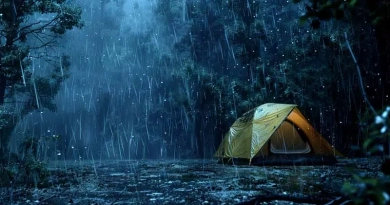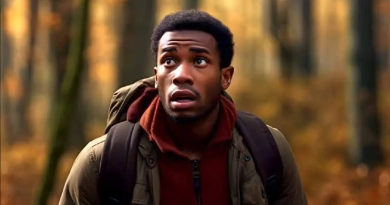
12 Ways To Select The Best Campsite
Selecting the best campsite is of the utmost importance when it comes to assuring three things: safety, comfort, and a small environmental impact.
When it comes to environmental safety, it’s hard to beat the lack of a sound that comes when you don’t have your tent set up in a windswept area. You could choose a site that has a close-to-ground wind tunnel effect or you could select the best campsite by choosing a site where the aforementioned sounds of silence reign. The way to that better path is to consider these 12 factors as you select a site.
 To develop an immediate aversion to camping, all you have to do is land at the wrong campsite! Your location could lure critters, make your tent unsteady, or subject your campfire to a fierce wind. If the rain gods are in a bad mood, you’ll be soaked and sleeping in a puddle by morning. Here’s what to consider so you can avoid those unfortunate outcomes and find a spot that’s just right.
To develop an immediate aversion to camping, all you have to do is land at the wrong campsite! Your location could lure critters, make your tent unsteady, or subject your campfire to a fierce wind. If the rain gods are in a bad mood, you’ll be soaked and sleeping in a puddle by morning. Here’s what to consider so you can avoid those unfortunate outcomes and find a spot that’s just right.
- Where you pitch your tent is critical. You want a level surface that is free of sharp objects and that also provides cover from the wind. You’ll look for the best spot near the cooking area and the bathroom—what campers call the “latrine.” Clearly, this is a space that requires some thought if you’re going to be in it for any amount of time. I get that. But don’t open up the tent on to a vista that commands the next valley, as Benjamin Lee Whorf did in pitching his tents along the Pima Trail in 1944.
- Importance of Drainage: To ensure that water doesn’t flood your tent during inclement weather, it is important that the proper drainage keep any pooled water away from your tent.
- To select the best campsite, look for sites that aren’t too flat. Slightly elevated or gently sloped sites will let water run off. Avoid depressions, coves, or any low-lying area where water can accumulate. In established campgrounds, look for tent pads that let water drain as effectively as possible; it’s a good sign if the pad is slightly raised.
Why Space Matters In Order To Select The Best Campsite
 While being near water makes cooking and cleaning much easier, there’s a big drawback. If you’re too close to a water source, you’re asking for trouble.
While being near water makes cooking and cleaning much easier, there’s a big drawback. If you’re too close to a water source, you’re asking for trouble.
- How to Do It Right: To select the best campsite, you need to be at least 200 feet distant from any lake, river, or stream. This space preserves the water in the source and the pathway for any critter that’s using you as a hurdle on its way to the water.
- Setting up your tent in Order to Steer Clear of Wind: If it is blowing hard enough, wind can turn your lightweight tent into a dangerous kite or can flatten it altogether. Your best defense against wind is to choose a site that has natural features to break the wind, such as large boulders or heavy woods. When you have those at your disposal, you simply set your tent up on the side where the wind is not coming from. Do not choose to set up camp in a place that is elevated and has any kind of feature that can expose you to wind.
- The Proper Sun and Shade Management: Sun and shade management can significantly impact your energy and comfort levels. In the morning, it is best to catch the sun for a short while to help you warm up. This is the solar effect, which in less energetic conditions (i.e., morning and evening) serves to further enhance the warmth of the tent. Of course, in hotter conditions, you would find a much cooler campsite if you could manage to escape to the shade of a tree or some other covering.
- Impact on the Environment, “Leave No Trace” Significance
- It is of the utmost importance to reduce our environmental impact if we want to ensure that the natural areas we cherish remain intact for those who come after us.
- How to Make It Happen: To select the best campsite, use campsites that are on the well-established path to least impact. Don’t pioneer a new one in a pristine area. When you do set up camp, make sure you do it on a surface that will withstand the forces of nature and also withstand campsite dynamics: rock, gravel, and bare soil (which is tougher than you might think). Whether you believe it or not, erosion happens through a lot of natural causes and through some campsite dynamics—big, heavy-footed hikers, for example.
To Select The Best Campsite, Do Not Camp in Sensitive Areas
 Camping in delicate ecosystems can cause great and long-lasting damage. Some of the best places in which to camp—meadows, the edges of water, and near fragile plants—are the worst places to camp because they are so easily damaged. When you are out in the woods, don’t offend Mother Nature. To select the best campsite, consider that the best sites in which to pitch your tent are likely to be along what has been dubbed “the camping highway.” The reason “highway” resonance applies here is that these sites are easily damaged, may take a long time to recover from being damaged, and are just all-around not okay to camp in. Instead, look for a site that is already established or where your presence will do the least damage.
Camping in delicate ecosystems can cause great and long-lasting damage. Some of the best places in which to camp—meadows, the edges of water, and near fragile plants—are the worst places to camp because they are so easily damaged. When you are out in the woods, don’t offend Mother Nature. To select the best campsite, consider that the best sites in which to pitch your tent are likely to be along what has been dubbed “the camping highway.” The reason “highway” resonance applies here is that these sites are easily damaged, may take a long time to recover from being damaged, and are just all-around not okay to camp in. Instead, look for a site that is already established or where your presence will do the least damage.
- Avoid Dangerous Places: Be aware of hazards. Why It’s Important: Accidents can happen anywhere, but poor campsite selection can lead to dangerous situations.
- Steer clear of camping beneath trees that are dead, leaning, or uprooted, beside loose rock ledges, or in low-lying areas with a history of flooding. Know the weather forecast for your trip and the kinds of natural hazards that are typical for your area and the current season—like avalanches, windstorms, or tornadoes—in order to avoid those potential dangers as much as possible.
- The proper storage of food: Proper food storage and the overall cleanliness of the campsite are critical if you want to keep animals away. Store food in containers that bears cannot get into. Or hang it from a tree in a place where it is not likely to tumble down or scratch open and where no animal could climb up and reach it. Clean up your campsite like it’s a cafeteria after lunch. Your campsite shouldn’t have any peeking-detective smells around it.
Convenience and Comfort: How Close to Trails and Amenities Should You Be?
 Carving out a lovely campsite takes some time and thought: It’s all about the details. If you’re in a developed campground, you can find spaces close enough to necessary amenities. But even if you’re not far from the bathhouse, you should still have a way to get to it and back without feeling like you’re on a federal road. If you’re in the backcountry, to select the best campsite, you need to think hard about the sort of people you’re willing to share your space with and for how long. You also need to consider your impact on the area around the trails you’re hiking.
Carving out a lovely campsite takes some time and thought: It’s all about the details. If you’re in a developed campground, you can find spaces close enough to necessary amenities. But even if you’re not far from the bathhouse, you should still have a way to get to it and back without feeling like you’re on a federal road. If you’re in the backcountry, to select the best campsite, you need to think hard about the sort of people you’re willing to share your space with and for how long. You also need to consider your impact on the area around the trails you’re hiking.- Campsite’s privacy and space: These greatly contribute to an enjoyable experience. I look for sites that put a comfortable distance between me and other campers. I make sure that there’s enough room for my tent and other gear so that I have the sense of being in my own space. If I’m camping with a group, I pay special attention to the site’s capacity so that we can avoid the “bumping into each other” experience that can make a campsite feel pretty claustrophobic.
Individual Needs and Conditions for Different Seasons
- Winter Camping: Pick campsites on snow or bare ground to create the least impact on the environment. Choose the proper site for maximum warmth. Avoid camping in low spots where cold air pools.
- Summer Camping: Seek out shade and good airflow to keep cool. Be aware that the risk of thunderstorms in the mountains increases dramatically in summer. Don’t camp on an exposed ridge.
If you take all these specifics into account, you can select the best campsite that offers a worry-free, pleasant, and eco-harmonic experience. Always follow the local rules and regulations to ensure the protection of the area’s natural resources and its wildlife.







